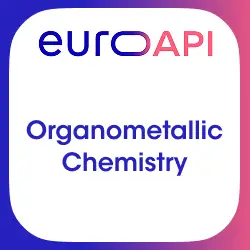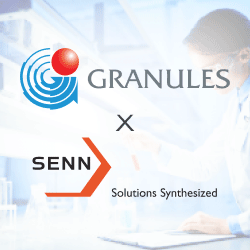BLOG
MARKET INTEL by PharmaCompass
CONTENT by Suppliers
- Interview #SpeakPharma
- Video #SupplierSpotlight
- Vlog #PharmaReel
- Company Bio #AboutSupplier
- Service Bio #AboutCapabilities
News
Create content with us, ask us


- CONTRACT MANUFACTURING
- CYTOTOXIC COMPOUND
- ANTIBIOTIC
- ANTIBODY DRUG CONJUGATE
- BIOLOGICS, BIOPROCESS & FERMENTATION
- CHIRAL SYNTHESIS
- CLINICAL SUPPLY
- CONTINUOUS FLOW PROCESS
- CONTROLLED SUBSTANCE
- CUSTOM SYNTHESIS & MANUFACTURING
- DISTILLATION / LIQUID API
- DRYING
- FINE CHEMICAL / INTERMEDIATE
- GMP MANUFACTURING
- HALOGENATION
- HAZARDOUS CHEMISTRY
- HIGH POTENCY APIS (HPAPIS)
- HIGH PRESSURE REACTION (> 100 PSI)
- HIGH TEMPERATURE REACTION (> 200 °C)
- HYDROGENATION
- LOW TEMPERATURE / CRYOGENIC CONDITIONS
- LYOPHILIZATION
- MICRONIZATION
- ORGANOMETALLIC CHEMISTRY
- OZONOLYSIS
- PHOSGENATION
- PLANT EXTRACTION
- PROBIOTIC
- PROCESS DEVELOPMENT & OPTIMIZATION
- PROCESS SAFETY ASSESSMENT
- PROTEIN / PEPTIDE
- REFERENCE STANDARD
- RESOLUTION OF RACEMIC MIXTURE
- SCALE UP
- SEPARATION & PURIFICATION
- SMALL SCALE BATCH
- INJECTABLE / STERILE APIS
- STEROID / HORMONE
- VITAMINS / MINERALS / INORGANIC SALTS
- CHROMATOGRAPHY
- OLIGOSACCHARIDES & POLYSACCHARIDES
- SMALL MOLECULES
- OLIGONUCLEOTIDE / POLYNUCLEOTIDE
- BIOPOLYMERS

01 Cyanation
02 Cyanation
03 Cyanation
04 Cyanation
05 Cyanation
06 Metal Hydride Reduction
07 Metal Hydride Reduction
08 Metal Hydride Reduction
09 Overview
10 Overview
11 Overview
12 Overview

01 Albemarle Corporation
02 Anacipher
03 Aragen Life Sciences
04 Arevipharma
05 CPL Sachse
06 CordenPharma
07 Curia
08 EUROAPI
09 Evonik
10 Grace
11 Inke S.A
12 Innovassynth Technologies (I) Ltd
13 Maithili Life Sciences
14 Malladi Drugs & Pharmaceuticals Limited
15 Minakem
16 Navin Fluorine International Limited
17 Neuland Laboratories
18 Olon S.p.A
19 SeQuent Scientific
20 Siegfried AG
21 Sreepathi Pharmaceuticals
22 TAPI Technology & API Services
23 UQUIFA
24 ZACH System SA

01 France
02 France
03 France
04 Germany
05 Germany
06 India
07 India
08 India
09 Israel
10 Italy
11 Spain
12 Spain
13 Switzerland
14 U.S.A
- Analytical > Analytical Method Development
- Analytical > Analytical Testing Services > Inhalation Products
- Analytical > BioAnalytical Services
- API & Drug Product Development > API Development
- API & Drug Product Development > API Development > Antibody Drug Conjugate
- API & Drug Product Development > API Development > Fine Chemical / Intermediate
- API & Drug Product Development > API Development > High Potency APIs (HPAPIs)
- API & Drug Product Development > API Development > Impurity / Reference Standard
- API & Drug Product Development > API Development > Oligonucleotide / Polynucleotide
- API & Drug Product Development > API Development > Oligosaccharides & Polysaccharides
- API & Drug Product Development > API Development > Overview
- API & Drug Product Development > API Development > Process Development & Optimization
- API & Drug Product Development > API Development > Protein / Peptide
- API & Drug Product Development > API Development > Separation & Purification
- API & Drug Product Development > API Development > Small Molecules
- API & Drug Product Development > API Development > Spray Drying
- API & Drug Product Development > Formulation Development
- API & Drug Product Development > Formulation Development > Buccal / Orodispersible
- API & Drug Product Development > Formulation Development > Capsule
- API & Drug Product Development > Formulation Development > Chewable / Suckable
- API & Drug Product Development > Formulation Development > Clinical Supply
- API & Drug Product Development > Formulation Development > Compounding
- API & Drug Product Development > Formulation Development > Controlled / Immediate / Modified Release
- API & Drug Product Development > Formulation Development > Controlled Substance
- API & Drug Product Development > Formulation Development > Granule / Pellets
- API & Drug Product Development > Formulation Development > Inhalation / Nasal
- API & Drug Product Development > Formulation Development > Injectable / Parenteral
- API & Drug Product Development > Formulation Development > Liquid Formulation
- API & Drug Product Development > Formulation Development > Lyophilization
- API & Drug Product Development > Formulation Development > Ophthalmic
- API & Drug Product Development > Formulation Development > Pediatric Formulation
- API & Drug Product Development > Formulation Development > Scale-Up Capabilities
- API & Drug Product Development > Formulation Development > Sterile Liquid Formulation
- API & Drug Product Development > Formulation Development > Suspension
- API & Drug Product Development > Formulation Development > Tablet
- API & Drug Product Development > Formulation Development > Topical
- API & Drug Product Development > Preformulation & Material Science > Particle Size Reduction & Micronization
- API & Drug Product Development > Preformulation & Material Science > Polymorph & Crystal Screening
- API & Drug Product Development > Preformulation & Material Science > Solubility Assessment & Enhancement
- API & Drug Product Development > Preformulation & Material Science > Taste Masking
- API Manufacturing > Antibiotic
- API Manufacturing > Antibody Drug Conjugate
- API Manufacturing > Biologics, Bioprocess & Fermentation
- API Manufacturing > Chiral Synthesis
- API Manufacturing > Clinical Supply
- API Manufacturing > Continuous Flow Process
- API Manufacturing > Contract Manufacturing
- API Manufacturing > Controlled Substance
- API Manufacturing > Custom Synthesis & Manufacturing
- API Manufacturing > Cytotoxic Compound
- API Manufacturing > Drying > Spray Drying
- API Manufacturing > Fine Chemical / Intermediate
- API Manufacturing > GMP Manufacturing
- API Manufacturing > Hazardous Chemistry
- API Manufacturing > High Potency APIs (HPAPIs)
- API Manufacturing > Micronization
- API Manufacturing > Oligonucleotide / Polynucleotide
- API Manufacturing > Oligosaccharides & Polysaccharides
- API Manufacturing > Organometallic Chemistry
- API Manufacturing > Organometallic Chemistry > Cyanation
- API Manufacturing > Organometallic Chemistry > Metal Hydride Reduction
- API Manufacturing > Ozonolysis
- API Manufacturing > Process Development & Optimization
- API Manufacturing > Protein / Peptide > Synthesis
- API Manufacturing > Reference Standard
- API Manufacturing > Scale Up
- API Manufacturing > Separation & Purification
- API Manufacturing > Small Molecules
- Clinical Trials > Compliance, Regulatory & Consulting
- Clinical Trials > Packaging & Logistics
- Clinical Trials > Medical Writing & Language Translation
- Clinical Trials > Patient / Investigator Recruitment
- Clinical Trials > Technology / Data / Analytics
- Drug Product Manufacturing > Biologic Drugs
- Drug Product Manufacturing > Capsule
- Drug Product Manufacturing > Capsule > Steroid / Hormone
- Drug Product Manufacturing > Compounding
- Drug Product Manufacturing > Cream / Lotion / Ointment
- Drug Product Manufacturing > Emulsion > Overview
- Drug Product Manufacturing > Gel > Overview
- Drug Product Manufacturing > Granule / Pellet
- Drug Product Manufacturing > Injectable / Parenteral
- Drug Product Manufacturing > Injectable / Parenteral > Overview
- Drug Product Manufacturing > Injectable / Parenteral > Pre-Filled Syringe
- Drug Product Manufacturing > Liquid
- Drug Product Manufacturing > Lyophilization
- Drug Product Manufacturing > Nasal
- Drug Product Manufacturing > Softgel Capsule
- Drug Product Manufacturing > Solution > Overview
- Drug Product Manufacturing > Spray
- Drug Product Manufacturing > Suppository
- Drug Product Manufacturing > Suspension > Overview
- Drug Product Manufacturing > Syrup
- Drug Product Manufacturing > Tablet
- Drug Product Manufacturing > Technologies
- Drug Product Manufacturing > Technologies > Orally Disintegrating Tablets (ODTs)
- Drug Product Manufacturing > Technologies > Taste Masking
- Packaging > Clinical Services
- Packaging > Contract Services
- Packaging > Contract Services > Serialization Compliance
- Packaging > Logistic Services
- Empty Capsules
- Empty Capsules > Clinical Supply
- Empty Capsules > HardGel
- Empty Capsules > Inhalation
- Emulsifying Agents
- Soft Gelatin
- Solubilizers
Overview of organometallic compounds & organometallic reactions for the organic synthesis of Active Pharmaceutical Ingredients (APIs), HPAPIs, etc.
Q1. What is organometallic chemistry?
Organometallic chemistry is the study of the synthesis, structure and reactivity of chemical compounds that contain metal-carbon bonds. Applied organometallic chemistry is useful for chemical synthesis, especially catalytic processes known as organometallic catalysis, often used in the production of fine chemicals. The field has provided a series of important conceptual insights, surprising structures, and useful organometallic catalysis reactions, both for industrial processes and for organic synthesis.
Organometallics, with their metal–carbon bonds, lie at the interface between classical organic and inorganic chemistry in dealing with the interaction between inorganic metal species and organic molecules. Usually, organometallic compounds are composed not only of typical metals, but also of metalloids such as boron, silicon, phosphorus, arsenic, selenium, etc.
Applied organometallic chemistry is among the most actively researched areas in organic, inorganic, biochemical, and catalytic chemistry. This arises from the use of organometallic reagents in the organometallic synthesis of a number of commercial compounds used in the pharmaceutical, polymer, and petrochemical industries. Without these organometallic reagents and catalysts, many of the existing synthetic manufacturing methods would be economically infeasible.
Some of the key points in the fast expansion of organometallic chemistry are the selectivity of organometallic complexes in organic synthesis (discovered with Grignard reagents at the end of the 19th century), and the interesting role that metals play in biological systems (e.g. enzymes, hemoglobin, etc.).
Types of Organometallic Chemistry Reactions (or Organometallic Reactions):
- Ligand dissociation/ligand association
- Reductive elimination/oxidative addition
- Alpha bond metathesis/4-centered reaction
- Insertion/deinsertion
- Lewis acid activation of electrophile
Q2. What are organometallic compounds?
Organometallic compounds have been known and studied for over 250 years. Many of these early compounds were prepared directly from metals by the oxidative addition of alkyl halides.
Organometallic compounds provide a source of nucleophilic carbon atoms which can react with electrophilic carbon atoms to form a new carbon-carbon bond. This is very important for advanced organic synthesis and the practical and scalable organometallic synthesis of complex molecules from simple starting materials.
Furthermore, all metals used in organometallic compounds have strong or moderately negative reduction potentials, with lithium and magnesium being the most reactive, and are consequently used as homogeneous catalysts.
Organometallic compounds have played a critical role in organometallic catalysis and organic synthesis, often leading to more efficient use of reagents, higher yields of products, and lower usage of energy. Organometallic compounds have also been used as precursors in the preparation of nanomaterials and microelectronic materials.
The physical and chemical properties of organometallic compounds vary greatly:
- Most are solids, particularly those whose hydrocarbon groups are ring-shaped or aromatic, but some are liquids and some are gases.
- Their heat and oxidation stability vary widely. Some are very stable, but a number of compounds of electropositive elements such as lithium, sodium, and aluminum are spontaneously flammable.
- Many organometallic compounds are highly toxic, especially those that are volatile.
Organometallic compounds have a broad range of applications in the field of applied organometallic chemistry:
- In some commercial, chemical reactions for the advanced organic synthesis or organometallic synthesis of chemical compounds, organometallic compounds are used as homogeneous catalysts.
- These compounds are used as stoichiometric organometallic reagents in both industrial and research-oriented advanced organic synthesis or custom organic synthesis and manufacturing.
- They also facilitate the protection and stabilization of unsaturated organic fragments
Q3. How are organometallic compounds synthesized?
There are various methods to synthesize organometallics, some of these are noted below:
Organometallic Reactions of Metals with Organic Halides
One of the most used methods to synthesize organometallics is to react the pure metal with specific organic molecules. The reaction of a metal with an organic halide is a convenient method for preparation of organometallic compounds of reasonably active metals such as lithium, magnesium, and zinc.
Double-decomposition Organometallic Reactions
A double decomposition reaction is a reaction in which the positive ions and negative ions in two compounds switch partners to form two new compounds. Metal halides exchange with alkylating reagents to yield organometallic reagents. Carbon monoxide reacts with transition metals to form metal carbonyls.
Decarbonylation of a Metallo-organic
Decarbonylation organometallic reactions involve the removal of one or more carbonyl groups from a metallo-organic molecule. The decarbonylation of metallo-organic compounds (chemical compounds that contain metals and organic ligands) will produce organometallics or organometallic compounds.
Hydrometalation Organometallic Reactions
Hydrometallation is the addition reaction of a metal hydride to a double bond (triple bond) to form an organometallic compound.
Various addition and elimination reactions form organometallic compounds from metallo-organic molecules. Choosing the optimal organometallic synthesis method is often informed by inline analytical techniques to ensure safe and efficient process development.
Q4. Who are the different service providers offering organometallic services?
Service providers offering organometallic services include:
Sanofi Active Ingredient Solutions
SAIS is an organometallic API CMO service provider. They offer organometallic services, advanced organic synthesis CMO capabilities & cGMP manufacturing of organometallic compounds by multistep reactions for active pharmaceutical ingredient (API) manufacturing.
PMC Isochem
Over 40 years PMC Isochem has developed a versatile technology platform offering cyanation for active pharmaceutical ingredients (APIs) and intermediates, biocatalysis, enzymatic catalysis, alkylation, hydrogenation, organometallic services (organometallic synthesis), halogenation and phosgenation for intermediate and API manufacturing.
Zach System
Zach provides custom API synthesis and manufacturing services for active pharmaceutical ingredients (API) & quality intermediates. They offer the following organometallic services: Metal hydride reduction, reductive amination, grignard reagents, cryogenic carbanionic chemistry and mild and catalytic C-C bond forming reactions.
Minakem
Minakem is capable of undertaking a broad range of multi-steps syntheses in organic chemistry. Their key technologies for active pharmaceutical ingredient (API) manufacturing include cyanidation, hydrogenation, high pressure reactions, chiral chemistry, hazardous chemistry & continuous flow chemistry.
Polpharma
Polpharma offers several complex chemistry & analytical services including organometallic chemistry, chiral, stereo and regioselective synthesis, catalytic hydrogenation, amino acids and peptide chemistry, polymorphism and solid state chemistry.All Suppliers
01
Pharma Service : API Manufacturing
SYNTHESIS OF ORGANOMETALLIC COMPOUNDS
Category : Organometallic Chemistry
Sub Category : Overview
Pharma Service : API Manufacturing
02
Pharma Service : API Manufacturing
CYANIDATION & FLOW CHEMISTRY SERVICES
Category : Organometallic Chemistry
Sub Category : Cyanation
Pharma Service : API Manufacturing
03
Pharma Service : API Manufacturing
04
Pharma Service : API Manufacturing
05
Pharma Service : API Manufacturing
ORGANOMETALLIC CHEMISTRY & CYANATION
Category : Organometallic Chemistry
Sub Category : Cyanation
Pharma Service : API Manufacturing
06
Pharma Service : API Manufacturing
CYANATION FOR API CUSTOM SYNTHESIS
Category : Organometallic Chemistry
Sub Category : Cyanation
Pharma Service : API Manufacturing
07
Pharma Service : API Manufacturing
Category : Organometallic Chemistry
Sub Category : Metal Hydride Reduction
Pharma Service : API Manufacturing
08
Pharma Service : API Manufacturing
CYANIDE HANDLING & BROMINIZATION
Category : Organometallic Chemistry
Sub Category : Cyanation
Pharma Service : API Manufacturing
09
Pharma Service : API Manufacturing
Category : Organometallic Chemistry
Sub Category : Metal Hydride Reduction
Pharma Service : API Manufacturing
10
Pharma Service : API Manufacturing
11
Pharma Service : API Manufacturing
ORGANOMETALLIC CHEMISTRY WITH HEXLI
Category : Organometallic Chemistry
Sub Category : Overview
Pharma Service : API Manufacturing
12
Pharma Service : API Manufacturing
13
Pharma Service : API Manufacturing
14
Pharma Service : API Manufacturing
15
Pharma Service : API Manufacturing
16
Pharma Service : API Manufacturing
17
Pharma Service : API Manufacturing
METAL HYDRIDE REACTION SERVICES
Category : Organometallic Chemistry
Sub Category : Metal Hydride Reduction
Pharma Service : API Manufacturing
18
Pharma Service : API Manufacturing
Category : Organometallic Chemistry
Sub Category : Metal Hydride Reduction
Pharma Service : API Manufacturing
19
Pharma Service : API Manufacturing
NON-NUCLEOSIDE METAL HYDRIDE REDUCTION
Category : Organometallic Chemistry
Sub Category : Metal Hydride Reduction
Pharma Service : API Manufacturing
20
Pharma Service : API Manufacturing
CYANATION & METAL HYDRIDE REDUCTION SERV...
Category : Organometallic Chemistry
Sub Category : Cyanation
Pharma Service : API Manufacturing
21
Pharma Service : API Manufacturing
CYANATION FOR APIs & ADVANCED INTERMEDIA...
Category : Organometallic Chemistry
Sub Category : Cyanation
Pharma Service : API Manufacturing
22
Pharma Service : API Manufacturing
23
Pharma Service : API Manufacturing
24
Pharma Service : API Manufacturing
ORGANOMETALLIC (ALKYL LITHIUM/LDA) REACT...
Category : Organometallic Chemistry
Sub Category : Overview
Pharma Service : API Manufacturing
25
Pharma Service : API Manufacturing
26
Pharma Service : API Manufacturing









 EUROAPI, the leading small molecules API player, provides both API sales & CDMO services.
EUROAPI, the leading small molecules API player, provides both API sales & CDMO services.















